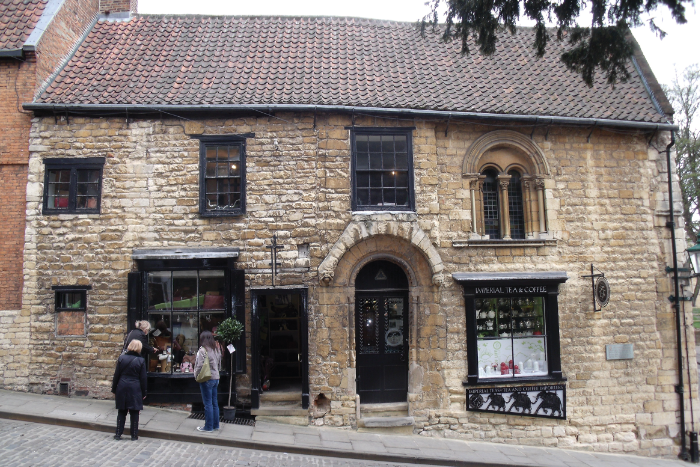
Where did Aaron Live?
Chris Johnson of the Survey of Lincoln investigates whether Aaron the Great had a home on the city’s Steep Hill.
The life of Aaron of Lincoln, often called Aaron le Riche, or even Aaron the Great, has attracted many tales and legends over the centuries. Whereas his business activities across the country, administered with the help of his sons and business partners, have been documented to a certain extent, his private life is largely unknown.
When Joseph Jacobs the Jewish historian looked into the origins of the Jewish community in medieval Lincoln in the 1890s, he visited the city to view the physical remains of that period, particularly the 12th Century building near the top of Steep Hill, now called the Norman House. He was told of a ‘tradition’, understood to be less than 50 years old at the time, that it was Aaron’s house.
The history of numbers 46-47 Steep Hill has subsequently been investigated as part of The Survey of Lincoln’s wider research of houses on Steep Hill, the Strait and the top of the High Street. As Sir Francis Hill pointed out in Medieval Lincoln in 1948, there is no record of Aaron living there. In the period c.1227/28, much new work was undertaken on the Castle defences, and it could be reasonably assumed that Aaron’s house was then hindering the works and had to be demolished. A similar situation arose with buildings near the Castle gateway in 1809, when the Judges’ Lodgings were erected.
Aaron held a large block of land on the west side of Steep Hill, possibly with houses on some of it, extending in each direction from a point opposite the Castle gateway, near the current Judges’ Lodgings, as far as the Castle ditch, and running south to the city wall. This was a substantial property holding, worth 40s. or 60s. per annum. Aaron’s house, situated on this site and valued at 6s. per annum, must have been a substantial property, taking up three average-sized plots.
One puzzle is why Aaron should have given up his house. This might have been part of a business deal, or an acknowledgment of the fact that he was spending most of his time in a magnificent house in Lothbury, in the City of London, rented from the Earl of Gloucester. On Aaron’s death, Henry II, in urgent need of funds, confiscated the whole of Aaron’s assets.
Another question that has arisen concerns Jewish settlement in uphill Lincoln generally. Were there any other Jewish-occupied houses in this part of the city? Although there was a relatively large Jewish community in the city in the mid-thirteenth century, there seems to have been a reluctance on their part to take houses in the Bail.
One Jewish resident was Judas de Ballio, who held an unidentified property in the Bail area for many years, until he was hanged alongside 17 other members of the local Jewish community who were convicted in the ‘Little St Hugh’ case of 1255, an expression of medieval antisemitism, in which they were convicted for their supposed involvement in the murder of nine-year-old Hugh.
In the case of Aaron, although it is now known, more or less, where he lived, just outside the eastern entrance to the Castle, the wrong attribution involving the Norman House continues to survive in some histories of the area.
(An extended version of this article can be found in The Survey of Lincoln’s publication Lincoln’s Castle, Bail and Close, which can be bought at the SLHA Bookshop, Jews’ Court, Steep Hill, and Lindum Books, Bailgate.)
You can find out more about The Survey’s work at www.thesurveyoflincoln.co.uk.
Photo:
Numbers 46-47 Steep Hill, dating from the 12th century and now a Grade 1 listed building, known as the Norman House. This was often incorrectly known as the house of Aaron of Lincoln. (Photo: Chris Johnson, reproduced courtesy of Lincoln Record Society)
